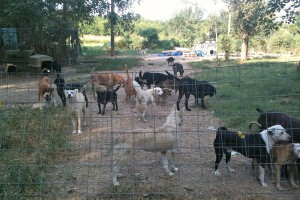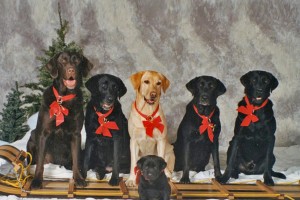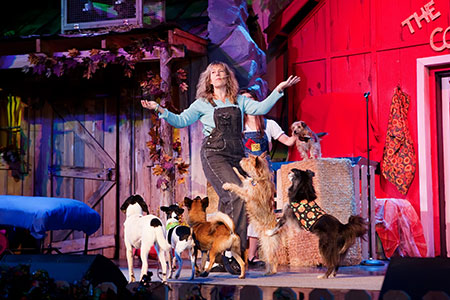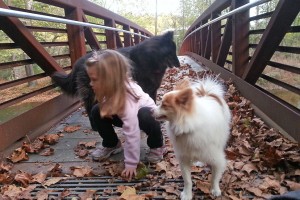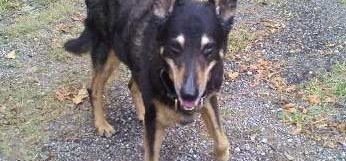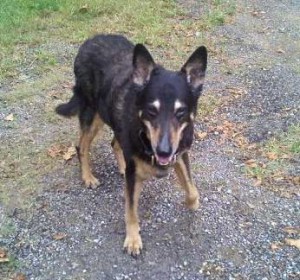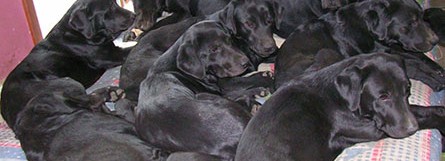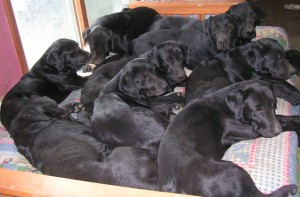This may not strike you as a multiple dog subject and strictly speaking, it isn’t. But it’s a dog behavior subject that affects all dogs so that is multiple enough for me. I have been mulling this subject over for some time now, prompted by recent conversations I have had with a couple of people, all via internet, which is never the best venue.
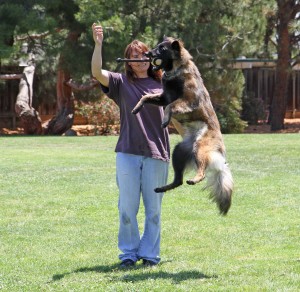
Denise Fenzi training with R+.
As anyone who has either read my book or knows me in person is aware of, I am a positive reinforcement trainer. That wasn’t always the case. I started my training knowledge with the more old fashioned techniques now known as “traditional” training.
At the time, it was simply the way that things were done. My fellow trainers and I were never intentionally harmful to the dogs that we were training or so we saw it that way. Of course the corrections that we issued to these dogs were intentional in that they were meant to be corrections. But did we see these forceful actions as harmful? Not at all. It was simply how we were told that dogs learned. But did they really learn? Sure, they did but at a cost and part of that cost was often a loss of trust. Humans are very unpredictable and can cause pain. They learned that right away. Best to avoid that pain by toeing the line that we drew. Dogs are amazingly adaptive. They can learn despite the failings of humans.
I will always have to live with the knowledge that my beloved Merlin and Kera were initially “trained” with choke chains and a harsh jerk on the leash. And let’s not forget scruff grabs and the like. My sweet Siri got far too familiar with a prong collar for during her late teenage months. Until I heard the cry of pain from one particularly enthusiastic launch forward during a hike, that is. That was the last time she had to bear that medieval device. It has made a great back gate latch since then.
My training method crossover did not happen fully overnight. I was dead set against using food rewards at first. But I attended my first positive training class with a dog from the shelter that I taught at, instructed by a local positive trainer who taught at another local shelter. I was initially horrified at the amount of food used. But I could not deny that my shelter ward for the class was attentive to what was taught. Soon I was bringing my own dog (Merlin) to the same trainer’s class with an eagerness that I never felt about my own classes. The transformation had begun.
The majority of that transformation was the fact that Merlin was not a dog that accepted corrections lightly. When they even made a dent in his consciousness, it was because he fought back. Merlin was a confident intelligent dog. He saw no need to be roughed up. When I learned a better way, the difference in attentiveness was like night and day. I had finally had the sense to give this brilliant dog the job that he had been craving. The end of his reactivity on leash to pretty much anything that moved had begun in earnest. I was delighted!
Years have passed and my knowledge has grown by volumes. My eyes have been opened. I have been thinking about this awakening in depth recently and I liken it to those pictures that get forwarded around where there are hidden images. Until you spot the image, you are confused and frustrated. Everyone else can see it, why can’t you? But then the skies clear, the image is undeniable and you wonder with amazement how you missed it even for a moment. As a dear friend says about other subjects, you can’t unsee it. Your life is forever changed. This is how I now see the balanced trainers versus positive reinforcement trainers division. I now see that image and that can never be changed. I wish they could see it too. It makes me sad that they can’t.
I will try very hard to explain this without judgment. Having been on the other side, I truly know that there is no cruel intent in most balanced trainers’ methods. I say most because some people will always take pleasure in their so called domination of another species. This is not said lightly. I have names in mind. This writing is not about those people. I do not feel that changing the view of those who feel that way is within my reach. Their path is in their control and they will follow it where they are directed to. I wish them clarity someday.
One of the questions I was asked recently was, did I think someone I know who is a balanced trainer hurts dogs? I said no initially because I truly don’t think she means to, as explained above. But after giving this more thought, the real answer is, “Yes, I do.” Using shock, jerks on choke chains or prong collars, and other physical corrections, DOES hurt. It’s designed to. That is the whole reason behind the use. Punishment does work. Correct the dog, he won’t do that again! But what does the dog learn from that? See above.
The dog in question does not change how he feels about what caused him to get issued a correction. He just learns that it hurts when he does that. It doesn’t mean he won’t do it again. It means that he will weigh his options and may choose what is more rewarding for him in the immediate moment at the expense of potential pain. This is a bad position to place a dog in.
The relationship suffers. There is no way of getting around that. There are various schools of thought that a dog should do whatever is asked simply because pleasing the human that asked is the best reward. It sure can be a huge part of it. But there are caveats to this.
That high of a value being placed on verbal acknowledgement as a reinforcement only comes with an already stellar relationship. If you are an unpredictable human and you sometimes cause pain, then you are not to be fully trusted and a verbal reinforcement will never be at the same level for a dog you are training than with a dog and human combo that has a trust filled relationship.
There, I said it. Let the flames begin. That is fact and you can spin it any way you want to try but that is how relationships work and we all know it. It’s the same with humans. Trust is trust. If you trust the person on the end of the leash to always have your back, then you will do pretty much anything for that person. Positive reinforcement training gives you and your dogs the opportunity to truly communicate with one another. It’s a two way conversation, with respect for both.
I realize that I must clarify the above somewhat. I am well aware that there are some crossover trainers who had great relationships with their dogs prior to crossing over. But I feel safe saying that these trainers have great skill with timing and that their corrections were rarely or never at the extreme end. The average dog parent who takes a class/has a private from/with a balanced trainer doesn’t have the same skill and understanding and the relationship will suffer.
Now none of this is not to say that positive trainers never lose their cool. We yell at our own dogs periodically, we have faults, we make mistakes, we are all human. But the effort to avoid having any emotional and physical pain in the name of forced compliance is a huge consideration. Again, this is not a judgment on those who I think simply have not seen that image. This is a plea to you to try to see that image. For your dogs, for the dogs you train. There is a better way.
I hear so much silliness from balanced trainers that well trained dogs trained by positive reinforcement is not the norm. We must have as our own dogs or train only soft dogs, not the dogs with drive like they train. Again, sorry to be blunt, but hogwash! I have dogs with “drive”. (what a silly term! It really just means a type A personality.) Merlin was never an easy dog to either live with or train but let me say, once I learned the right way to train, he was a pleasure! I could take him anywhere. He could be off leash standing next to a deer and he would come to me to be rewarded for ignoring said deer. I work with dogs like this all the time. I help clients turn reactivity and aggression around all the time. As with any client base, owner compliance is important to success. But success is the norm here. I am also far less worried about the damage that my clients can do to their dogs with bad timing of verbal markers and treats than giving them the permission to jerk their dog when the feel the need!
Anger is easy to escalate. Having been in this position, I say this with conviction: it’s far easier to simply jerk a leash again when “compliance” is not forthcoming than to take the moment to show the dog what you want instead. Anger begets anger. I choose to show people how to teach their dogs to make better decisions and to give their dogs a voice in the outcome of any situation. I can sleep better this way and I know that the majority of my clients do as well.
This is a subject dear to my heart so I need to curtail my ramblings now or I will fill far too many pages for this article! I will end this with some comments from other cross over trainers on what moment gave them pause to “cross over”, edited for space.
Dawn Elberson Goehring in Gaitlinburg, TN is in the entertainment business at the Comedy Barn Theater with her dogs. With a background in working with wildlife, which involves hands off training, she could not understand why leashes were needed to train a dog. So she went hands off with her trick training and found an amazing attitude with her dogs that serves her as well with training clients today.
Nan Arthur, trainer in Lakeside CA and member of the faculty at Karen Pryor Academy and author of “Chill Out Fido”, says that her defining moment was attending a class with her six month old puppy and seeing the instructor correct another dog so hard that he was slammed into a brick wall because of his barking. She walked out and found a better way.
Pat Miller, owner of Peaceable Paws in Fairplay, MD and author of numerous books on positive training as well as training editor of the Whole Dog Journal, states that her light bulb moment came when her marvelous dog Josie ran and hid under the deck when she brought out her utility dog equipment. She never looked back from that moment. It is well documented what has resulted since then!
Miranda Workman, trainer in Amherst, NY and former president of the CCPDT, offers that her Boxer who had been attacked by another dog, became reactive and was made worse by punishment based training techniques. He was no longer safe to be around. This situation helped her not only cross over but to become a professional trainer.
Casey Lomonaco, of Rewarding Behaviors Dog Training in Endicott, NY has Monty to thank for her awakening. I cannot possibly edit her story and still do it justice so simply read it for yourself here. http://projectmonte.wordpress.com/about/
All these situations have something in common: they saw the image in the picture. For those of you who have seen the image, feel free to share your story here as well. For those who have yet to see the image, if you are local, come watch me work. If you are not, call a qualified positive trainer and ask to watch her/him work. I wish you clarity.
Tags: attack, balanced, choke, correction, cruel, dogs, food, harm, jerk, leash, many, multiple, pain, positive, prong, puppy, reinforce, respect, reward, shelter, train, trust
Posted in: Projects





